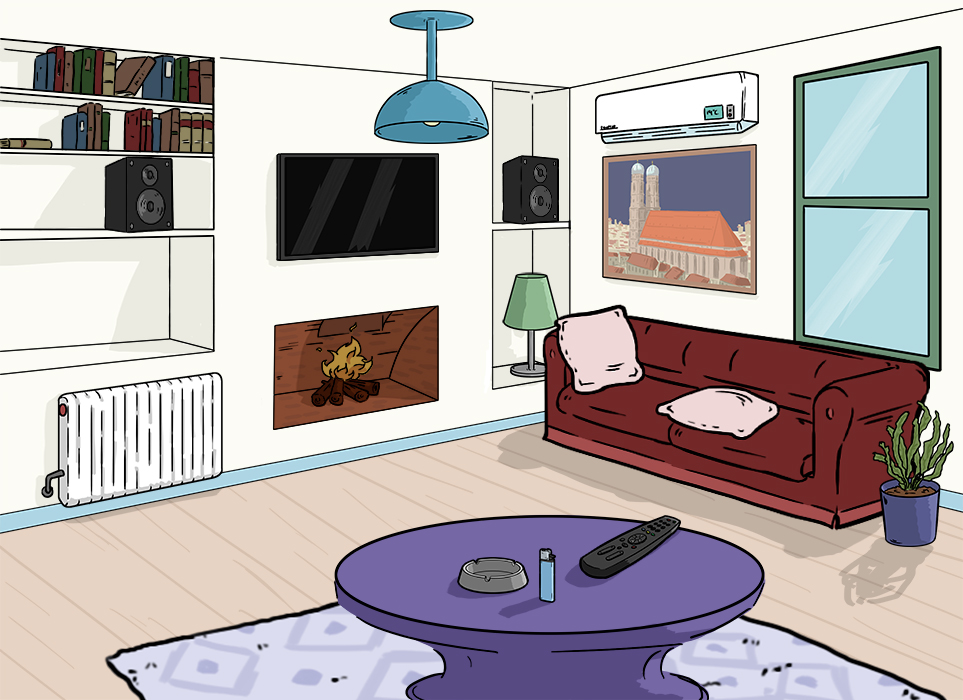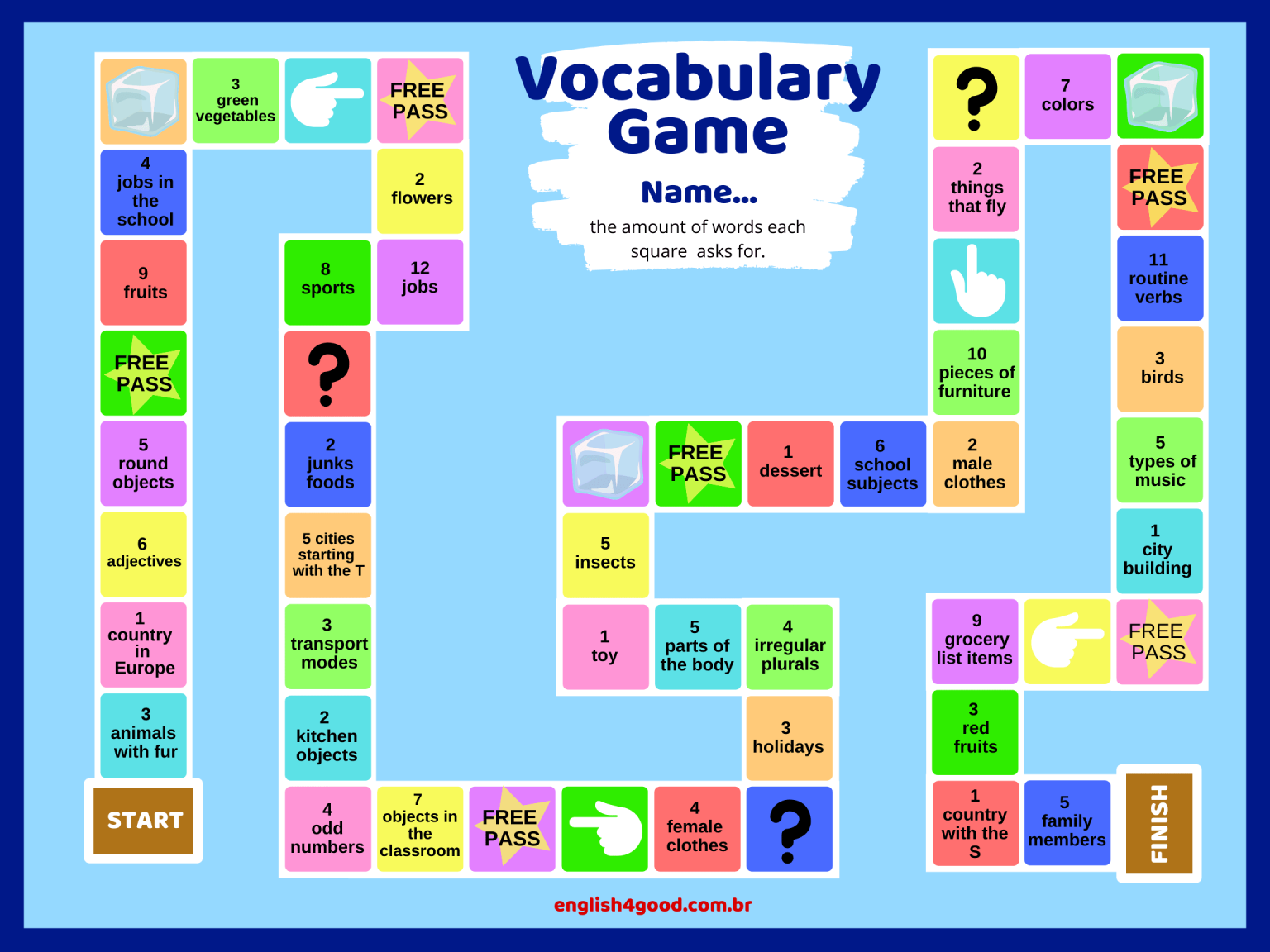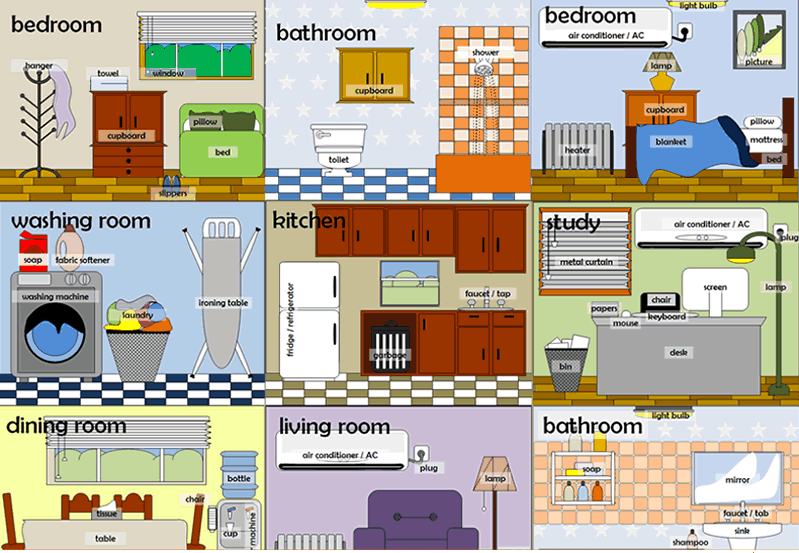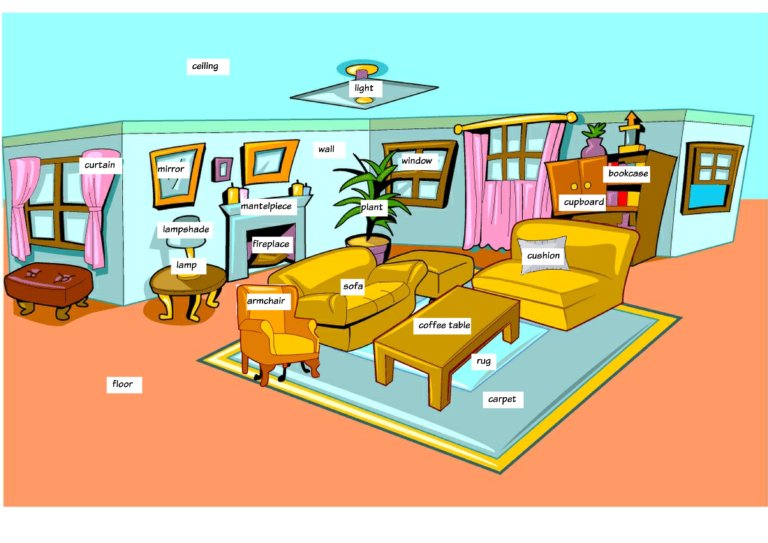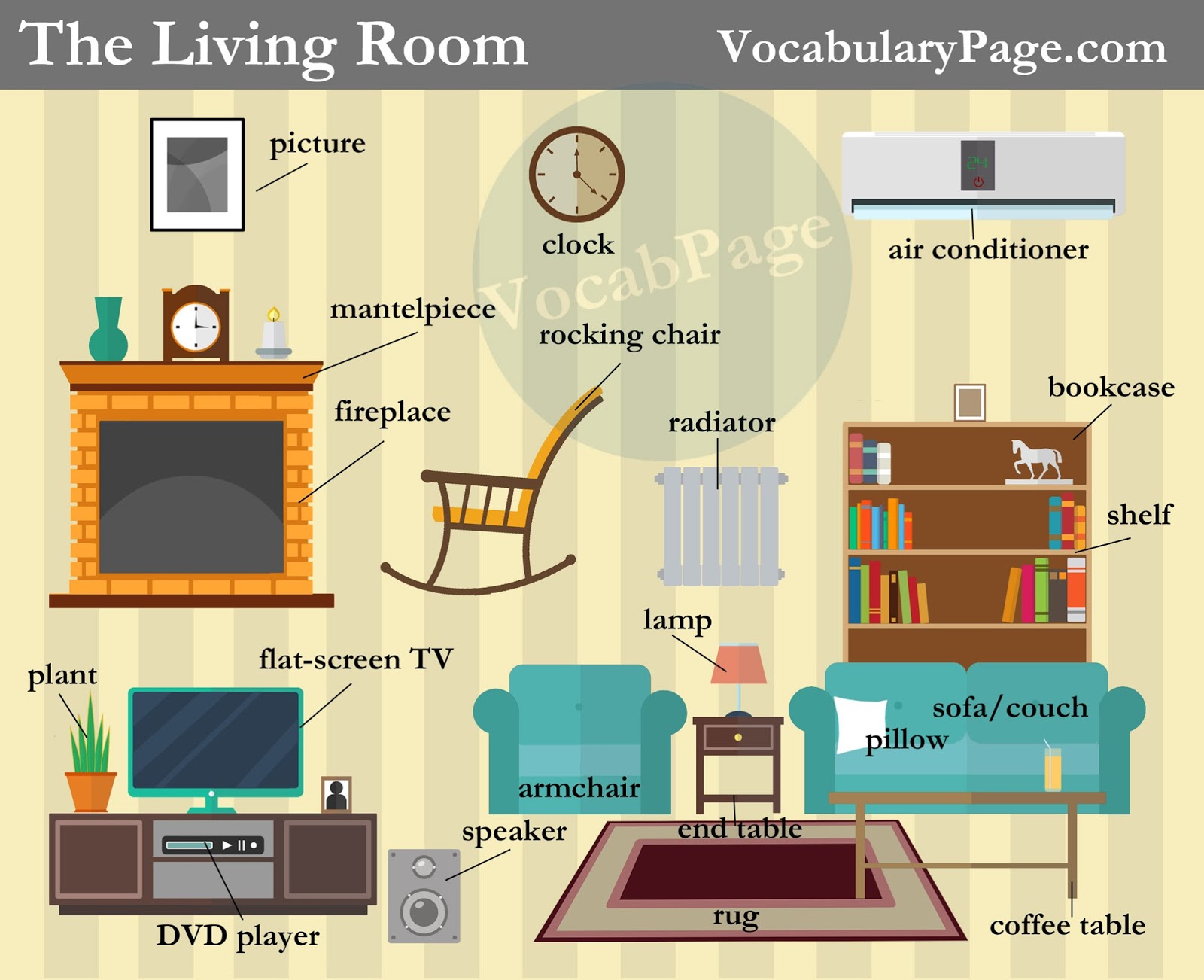If you're an ESL teacher looking for fun and engaging ways to teach living room vocabulary to your students, look no further. We've compiled a list of the top 10 ESL activities that will not only help your students learn new words, but also have a blast while doing so. So let's get started!Living Room Vocabulary ESL Activities
Before we dive into the activities, let's review some essential vocabulary words related to the living room. These words are commonly used in everyday English conversations and will be useful for your students to know. Featured Keywords: living room, sofa, coffee table, television, lamp, rug, armchair, curtains, bookshelf, fireplaceEnglish Vocabulary for Living Room
1. Living Room Scavenger Hunt: Create a list of living room items and have your students search for them in the classroom. This activity not only helps students learn new words, but also familiarizes them with the objects in a living room. 2. Memory Game: Place a variety of living room items on a tray and show it to your students for a few seconds. Then, cover the tray and have students try to remember as many items as they can. They can then take turns naming the objects they remember. 3. Role-Playing: Have students act out different scenarios in the living room, such as hosting a party or watching a movie. This will not only help them practice using new vocabulary words, but also improve their speaking and listening skills. 4. Word Association: Write a living room word on the board and have students brainstorm related words. For example, if the word is "sofa", students can come up with words like "cushions", "pillows", and "comfortable". This activity is great for expanding vocabulary and making connections between words. 5. Pictionary: Divide students into teams and have them draw living room items while their team members try to guess the word. This game is not only fun, but also encourages creativity and teamwork.ESL Activities for Teaching Living Room Vocabulary
6. Bingo: Create bingo cards with different living room items and have students mark off the items as you call them out. This game is a great way to review vocabulary and can be played in groups or individually. 7. Charades: Similar to Pictionary, have students act out living room words without speaking while their classmates try to guess the word. This game is a fun way to review vocabulary and get students moving. 8. Word Search: Create a word search puzzle with living room words for students to complete. This activity not only helps students learn new words, but also improves their spelling and concentration skills.Living Room Vocabulary Games for ESL Students
9. Picture Dictation: Describe a living room scene to your students and have them draw what you say. This activity not only helps students practice listening and following instructions, but also reinforces vocabulary words. 10. ESL Vocabulary Worksheets: There are many worksheets available online that focus on living room vocabulary. These can include matching exercises, fill-in-the-blank activities, and more. You can also create your own worksheets tailored to your students' needs.Teaching Living Room Vocabulary to ESL Learners
Incorporating games and activities into your lesson plans is a great way to make learning fun and engaging for your students. These activities will not only help them learn new words, but also improve their overall English skills.Fun ESL Activities for Learning Living Room Vocabulary
Worksheets are a great way to provide extra practice and reinforce vocabulary words. They can also be used for homework assignments or as a warm-up activity at the beginning of class. Featured Keywords: ESL, students, living room, vocabulary, worksheets, activitiesLiving Room Vocabulary Worksheets for ESL Students
In today's technology-driven world, it's important to incorporate interactive activities into your lesson plans. Here are some ideas for interactive living room vocabulary activities: 1. Online Quizzes: There are many websites that offer interactive quizzes for ESL students. You can create a quiz specifically focused on living room vocabulary or find one that already exists. 2. Virtual Tours: Show your students virtual tours of different living rooms around the world and have them describe what they see using the vocabulary words they have learned. 3. Memory Games: There are many online memory games that focus on living room vocabulary. These are a fun and interactive way for students to review and practice new words.Interactive Living Room Vocabulary Activities for ESL Learners
It can be overwhelming to come up with new lesson plans each week, so here are some ideas for lesson plans focused on teaching living room vocabulary: 1. Labeling: Have students label objects in a living room scene with their corresponding vocabulary words. This activity can be done as a class or in small groups. 2. Storytelling: Have students create a story using as many living room words as they can. This activity not only helps students practice using new vocabulary, but also encourages creativity and storytelling skills. 3. Vocabulary Builder: Have students create their own vocabulary builder with living room words. This can include definitions, synonyms, and example sentences. They can then use this as a reference when learning new words.ESL Lesson Plans for Teaching Living Room Vocabulary
Flashcards are a useful tool for visual learners and can be used in a variety of ways. Here are some ideas for using living room vocabulary flashcards in your ESL classroom: 1. Memory Game: Use flashcards to play a memory game, similar to the one mentioned earlier. This is a fun and interactive way for students to review and practice new words. 2. Charades: Use flashcards to play a game of charades, similar to the one mentioned earlier. This activity encourages students to use their bodies to act out vocabulary words, making it a fun and engaging way to learn. 3. Matching Game: Have students match flashcards with their corresponding words. This is a great activity for reviewing vocabulary and can be done individually or in pairs.Living Room Vocabulary Flashcards for ESL Students
The Importance of Teaching Living Room Vocabulary in ESL Activities

Why is it important to teach living room vocabulary?
 Living room vocabulary is an essential part of learning a language, as it allows students to communicate about their immediate environment and daily activities. In ESL activities, teaching living room vocabulary is crucial as it not only helps students improve their language skills, but also their cultural understanding. By learning living room vocabulary, students are able to describe their living spaces, learn about different cultural norms, and engage in meaningful conversations with native speakers.
Featured Keywords: living room vocabulary, ESL activities
Living room vocabulary is an essential part of learning a language, as it allows students to communicate about their immediate environment and daily activities. In ESL activities, teaching living room vocabulary is crucial as it not only helps students improve their language skills, but also their cultural understanding. By learning living room vocabulary, students are able to describe their living spaces, learn about different cultural norms, and engage in meaningful conversations with native speakers.
Featured Keywords: living room vocabulary, ESL activities
How to incorporate living room vocabulary in ESL activities?
 There are many fun and creative ways to incorporate living room vocabulary in ESL activities. One effective method is by using real-life scenarios and role-playing. For example, students can act out a conversation between roommates discussing their living room furniture or decorations. This not only helps students practice their language skills, but also allows them to imagine and create their own living space. Other activities include creating a living room vocabulary scavenger hunt, where students have to find and label items in a picture of a living room, or creating a living room vocabulary memory game.
Featured Keywords: real-life scenarios, role-playing, living room vocabulary scavenger hunt, memory game
There are many fun and creative ways to incorporate living room vocabulary in ESL activities. One effective method is by using real-life scenarios and role-playing. For example, students can act out a conversation between roommates discussing their living room furniture or decorations. This not only helps students practice their language skills, but also allows them to imagine and create their own living space. Other activities include creating a living room vocabulary scavenger hunt, where students have to find and label items in a picture of a living room, or creating a living room vocabulary memory game.
Featured Keywords: real-life scenarios, role-playing, living room vocabulary scavenger hunt, memory game
Benefits of teaching living room vocabulary in ESL activities
 Teaching living room vocabulary in ESL activities has many benefits for students. It not only helps them improve their language skills, but also their critical thinking and creativity. By engaging in activities that incorporate living room vocabulary, students are able to use the language in a meaningful and practical way. This helps them become more confident and fluent speakers. Additionally, learning about different cultures through living room vocabulary can broaden students' perspectives and understanding of the world.
Featured Keywords: language skills, critical thinking, creativity, cultural understanding
Teaching living room vocabulary in ESL activities has many benefits for students. It not only helps them improve their language skills, but also their critical thinking and creativity. By engaging in activities that incorporate living room vocabulary, students are able to use the language in a meaningful and practical way. This helps them become more confident and fluent speakers. Additionally, learning about different cultures through living room vocabulary can broaden students' perspectives and understanding of the world.
Featured Keywords: language skills, critical thinking, creativity, cultural understanding
In conclusion
 Teaching living room vocabulary in ESL activities is crucial for students to effectively communicate in a new language and gain a deeper understanding of different cultures. By incorporating fun and interactive activities, students are able to improve their language skills, critical thinking, and creativity. As educators, it is important to emphasize the importance of learning living room vocabulary and provide students with opportunities to practice and use the language in a meaningful way.
Teaching living room vocabulary in ESL activities is crucial for students to effectively communicate in a new language and gain a deeper understanding of different cultures. By incorporating fun and interactive activities, students are able to improve their language skills, critical thinking, and creativity. As educators, it is important to emphasize the importance of learning living room vocabulary and provide students with opportunities to practice and use the language in a meaningful way.




